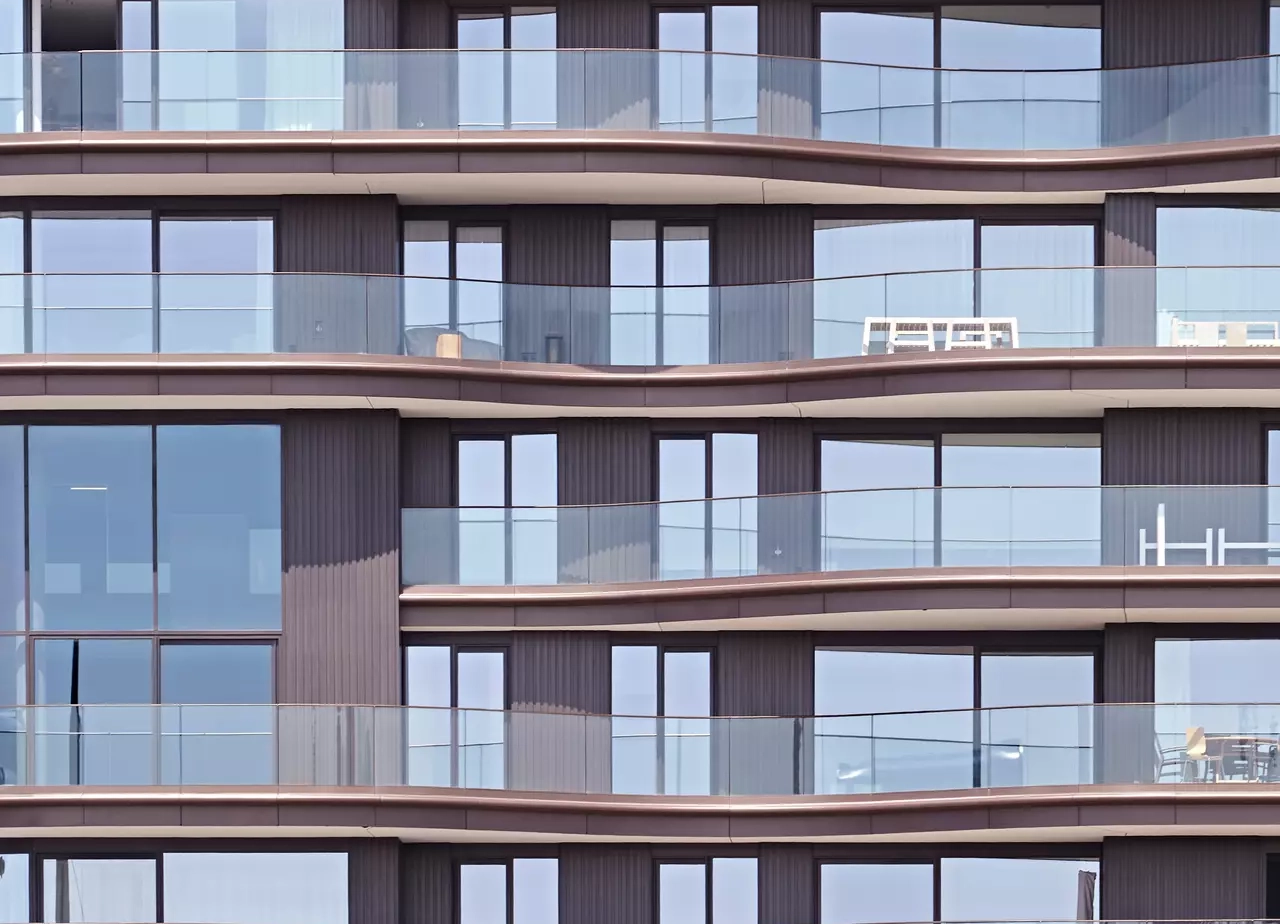
Linarte pushes architectural boundaries with One Baelskaai
One Baelskaai is the figurehead of the East Bank, in Ostend’s historic port. Binst Architects gave the iconic corner building commissioned by the Versluys Group undulating patios and expressive patio borders. To evoke the dune grass and dune fencing, the architects chose Renson Linarte brown-black/bronze profiled façade cladding to contrast with the flowing horizontal lines. We spoke to Binst Architects about the search that preceded this.
ARCHITECT: Binst Architects
DEVELOPER: Versluys Group
INSTALLER: Habemo
FACADE CLADDING: Linarte
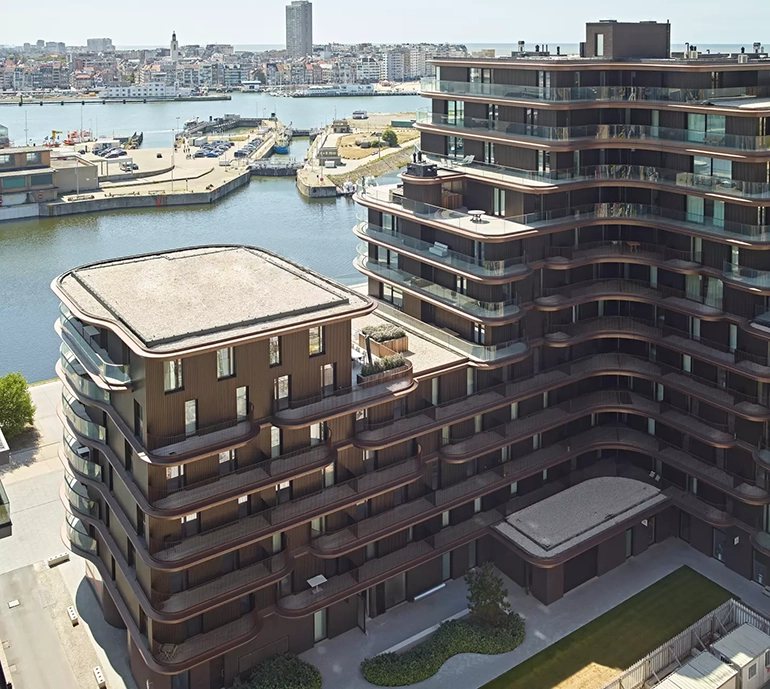
Pioneering icon
“At the time, Binst Architects won the competition launched by Versluys Group among three Belgian architectural firms,” project architect Ward Lagrain interjects. He co-submitted the permit, and then worked through the tendering and the whole site process. “Plans were already in place for the East Bank urban redevelopment project, located between the port mouth, scouring basin, urban forest, and dunes on the east side of Ostend. Versluys wanted an iconic, residential corner building with a high-end finish for the Vuurtoren district site, and they already had a master plan for that, too. They felt that this prominent corner – where the sun hits perfectly and there’s a view of the sea from a certain height – deserved an outstanding project in which architectural boundaries could be pushed.”
Development of the plan
“This project presented a challenge but also a luxury. As mentioned, a master plan already existed for this project. Those plans were already quite concrete thanks to Ghent-based drawing office Piet Coopman. That office had already determined where the basement and cores would be. Versluys had already largely determined how many apartments there would be and the associated surface areas, and the layout of those spaces was also largely already determined. We could very experimentally examine the façade and patios in terms of shape, appearance, and material usage. Not every project allows you to go into such detail during the study phase. You’re quite often hampered by strict budget requirements. Those requirements were there now too, but they were in a slightly different order of magnitude.”
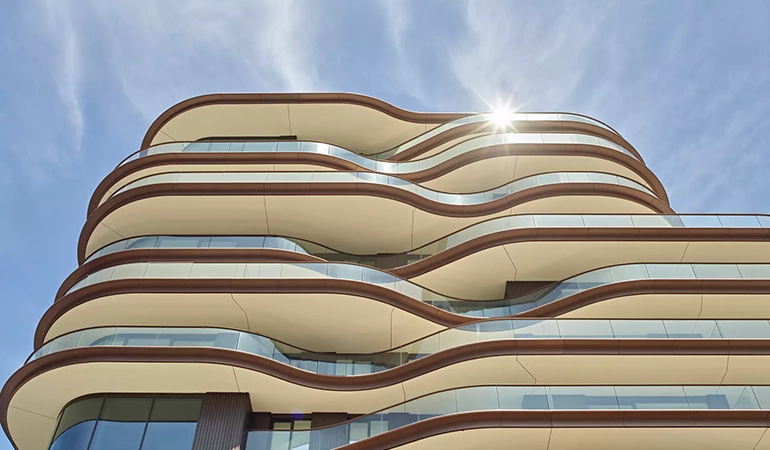
Focus on façade
“We didn’t have to go into details on a plan basis for this project, which allowed us to fully focus on the outside. The luxury apartments are large and Versluys knew that they already had a marketable project at that location on a plan basis. Only they don’t have the expertise to design ground-breaking façades. Which is why they contacted us. The façade reflects the character of the site, port area, and coast. The patios and their expressive patio borders give the complex a unique look and maritime character. The building’s undulations mirror the undulating character of the dune landscape in front and the sea. Undulating continuous glass balustrades reflect light, air, and water.”
Like the sculptural layering of the dunes and the fine dune grass, the sloping terrace borders and vertical profiling represent this architectural interpretation
Luc Binst, Binst Architects
Material usage
The material usage at One Baelskaai also refers to the surrounding dune landscape. The profiled Linarte façade cladding by Renson evokes the image of the dunes. Although Linarte offers the possibility of personalisation by adding wooden inserts or led lights, the architect chose the clean, sleek look. “Our decision to use Linarte wasn’t made on the spur of the moment. The yard was already at level +3 in structural work when the Renson product came into the picture. As architects, we did say that we wanted a vertically profiled façade that hinted at the dune grass and the wooden posts with barbed wire that demarcate the dunes. That subtle vertical reference in our façade contrasts nicely with the horizontally sloping patio borders. However, we and Versluys weren’t immediately sure exactly what that material should be. Aluminium was an option from the very beginning but we were also looking at other materials.”
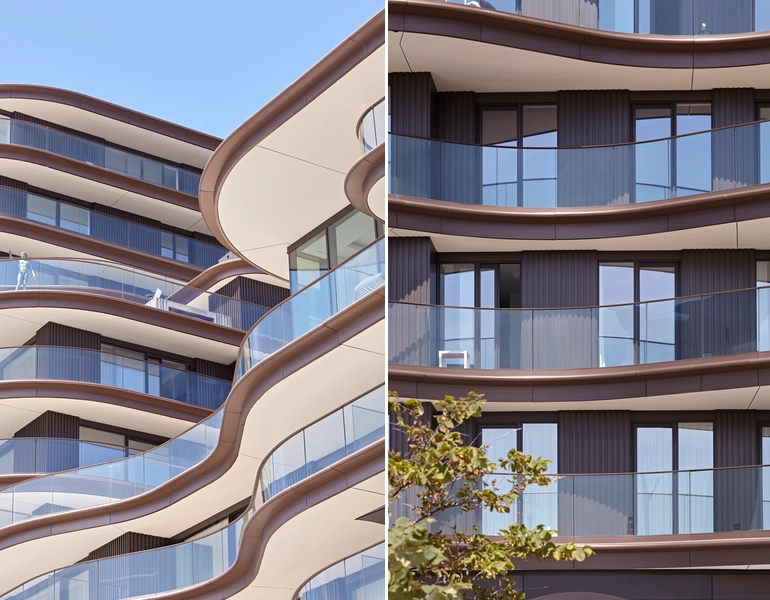
No wood
Wood would have been an obvious solution, but that turned out not to be so obvious.
“Wood was ruled out because of fire safety for high-rise buildings. The legislation has been further tightened since the Grenfell Tower fire in London (2017). This would require fireproofing treatment of the wood every few years. That is not really sustainable and besides, you have to periodically disturb the residents of the apartments for that façade maintenance.”
No terracotta
Terracotta was also considered as a possible option, but again, there proved to be too many drawbacks.
“The big disadvantage of terracotta is the weight of the material. All combined, it’s quite heavy. Moreover, that material – terracotta = ‘baked earth/clay’ – isn’t always tightly delineated and uniform. An issue also arose because we wanted the façade material to be reflected in the curved patio nose. So the terracotta would also have had to be bent in 3D, on top of the already not to be underestimated price tag of the material. As a final death knell, a terracotta finish also needs a lot of grouting. So we decided to ignore this material as well.”
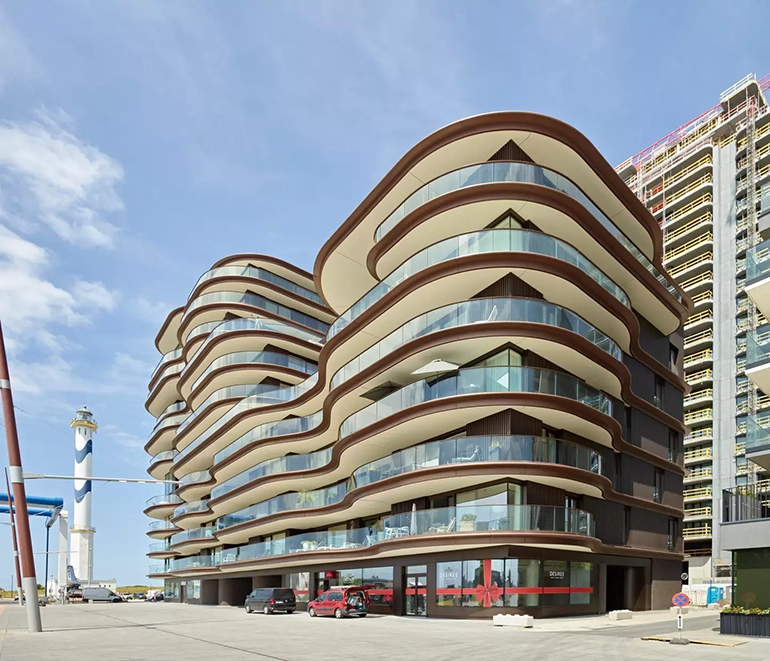
Hello Linarte
After all that backtracking on the materials search, Binst Architects arrived at aluminium profiled façades, such as Renson’s Linarte. “At that time, the site was already full of activity. For example, windows had already been installed at One Baelskaai that were not sized for a particular façade cladding. Of course, this played out in Renson’s favour; to our knowledge, Linarte is the only system on the market where it is possible to have a bit of margin per profile blade. The aluminium façade cladding adapts perfectly to the different sizes between the windows so we were able to finish on a full size. This way, we obtained a logical façade, without having to cut profiles here and there. We believe this system is a good way to attach aluminium to the façade. We did chose a custom made Linarte solution. The profiles on One Baelskaai have the depth of the Block 30, but the width was scaled to a nominal step of 120 mm. This way the Linarte structure pops out on this grand project. With those specifications, you can adapt the step from min. 108 to max. 124 mm. It’s also a ‘unique’ façade in that sense. Well over 2.500 m² of Linarte façade cladding was used. We are very familiar with Renson products since we designed the Renson headquarters in Waregem and Renson Outdoor/NOA in Kruisem, among other things. We’ve had a good relationship with the company for years.”
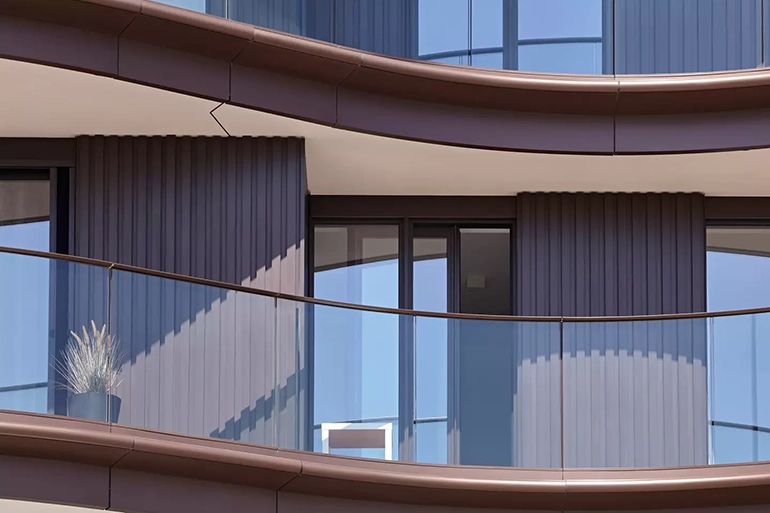
Resort vibe
“We think the bronze/brownish-black colour of the Linarte profiles exudes a kind of domesticity. In any case, it’s less harsh than standard black or grey and has more of a ‘resort’ vibe. This allowed us to give the cold aluminium a warm hue that combines nicely with the natural sandy shades. We didn’t really have a say in the interior design of this project, but our colleagues obviously drew their inspiration for the interior from the exterior elements. That way, there is consistency between the entrance halls and the exterior.”
Satisfaction and compliments
When asked how he looks back on the One Baelskaai project, Luc Binst sounds like a satisfied man, “We are very pleased that Binst Architects got the opportunity to push an architectural boundary. One Baelskaai is a one-of-a-kind building in Flanders. For example, the study of the patio border was also very challenging. That quest took years. To do so, we went to Germany, among other places, for research and went into a very high level of detail with VK Engineering. When you then see the result afterwards… those 2 km long borders that fit nicely all the way around the building, all the tolerances that are finely tuned… naturally, that’s very satisfying. The great thing is also that during the tour/delivery, I still had the chance to speak to some of the One Baelskaai residents. They were already very satisfied with the aesthetics of the building. We have received nothing but compliments on the beauty of the building.”
